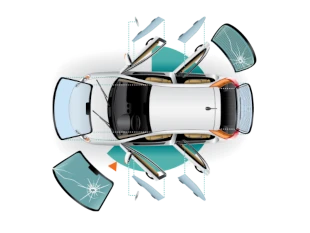Car Shakes When Braking? 3 Main Reasons For Every Vehicle.

There are many car makes and models on the market, so you may assume that you won’t find helpful information in this blog post because it’s not specific to any car model. This is actually not true. There are not that many brake manufacturers for most cars around, and they all work similarly. The reasons and solutions I’ll provide here WILL fit your car as well.
In this blog post, I’ll briefly explain how car brakes work and why it’s essential to know that to understand why your car shakes when braking. I’ll also discuss the exact reasons and solutions for that.
By understanding how your brakes work, you can quickly troubleshoot the problem and save yourself some money and time. So don’t be discouraged – take a few minutes to learn about your car brakes, and you’ll be glad you did!
Use this table of contents for easy navigation through the article
> Car Manufacturer Doesn’t Make Brakes For Your Car Themselves
> Your Car May Have 2 Different Types of Brake Systems
> Structure of Braking System on Modern Vehicles
> Structure of brake caliper
> How Disc Brakes Work
> What Causes Brakes to Shake or Vibrate (Disc Brakes)
> Reason 1 – Warped Brake Rotors
> Solution for warped brake rotors
> Reason 2 – Loose Lug Nuts or Bolts
> Reason 3 – Worn Suspension Components
> How To Allocate Where Brakes Are Bad When They Shaking
> Conclusion
Car Manufacturer Doesn’t Make Brakes For Your Car Themselves
Carmakers have to juggle a lot of balls when it comes to putting together a new vehicle. They must design the car, engineer it, source materials and components, line up suppliers, and more. It’s a lot to manage, which is why many automakers outsource some of their work. One area where this is common is with Original Equipment Manufacturing or OEM.
When a carmaker outsources OEM work, it’s basically hiring another company to make parts or components that will be used in the final product. This can be anything from engines to transmissions to brake systems on your vehicle.

That’s why if you drive a GMC, you most likely don’t have GMC brakes installed on your car. In fact, GMC uses a company named ACDelco, which makes brakes not only for them. ACDelco also makes brakes for all General Motors group, which includes car manufacturers like Chevrolet, Buick, Cadillac, and GMC.
Your Car May Have 2 Different Types of Brake Systems
When it comes to vehicle braking systems, there are generally two types that are used in most modern vehicles: disc brakes and drum brakes.

Disc brakes
The first type is the disc brake system, which is typically found in the front or/and rear wheels. This system uses a set of brake pads that grip onto a spinning disc (called disc brake rotors) to slow down or stop the vehicle. These brakes are very efficient but require attention and more frequent maintenance.
I’ll mainly discuss this type of system today regarding shaking or vibrating while braking, as another type, rarely has the same problems.
Drum brakes
The second type of braking system is the drum brake system, which is usually found only on rear wheels. This system uses a set of shoes that press against the inside of a drum in order to create friction and slow down or stop the vehicle. Drum brakes are not as efficient as disc brakes, but they wear out less and require less maintenance.
Both systems have pros and cons, so it depends on your specific vehicle weights and powers as to which one will be best suited for you.
Structure of Braking System on Modern Vehicles
Your car’s brake system is composed of many different parts that work together to stop your vehicle when you hit the brake pedal. There are the main components of your car’s brake system:

- Brake fluid reservoir – stores the brake fluid that is used to power the brakes;
- Master cylinder – pump that pressurizes the brake fluid and sends it to the calibers;
- Brake pedal – is what you step on to engage the brakes;
- Brake lines – pipes that carry pressurized brake fluid from the master cylinder to the calibers;
- ABS block – a computer that controls the braking system and helps to prevent wheels from locking up;
- Brake hoses – flexible tubes that connect brake system elements between the car’s moving parts;
- Brake calipers – are what actually squeeze the brakes pads against the rotors to stop your vehicle;
- Brake rotors – are what your car’s wheels sit on, and they spin when your vehicle moves;
- Brake pads – are what contact the rotors and create friction to stop your car.
Structure of brake caliper
It’s important to understand from what parts calipers are made, as these parts are often the reason for failure in the system.

- Caliber itself
- Caliber bracket – a part that holds caliber to the car;
- Bleeding bolt – used for bleed air from brake liquid in caliber;
- Piston – a component that is pushing pads against the rotor;
- Rubber manchet – protects piston from moisture and rust;
- Rubber seal – preventing brake fluid from leaking between piston and caliber;
- Guide pins and their rubber seals – caliber is moving on these pins against the bracket, allowing the brake pad to release.
How Disc Brakes Work
- When the driver presses the brake pedal, hydraulic fluid is sent from the master cylinder to the calipers. The calipers are located at each wheel and house the brake pads.
- When the liquid reaches the calipers, it applies pressure to a piston inside the caliper. The piston then presses the brake pad against the spinning disc or brake rotor.
- The friction between the pads and rotor slows down the wheel, bringing the car to a stop.

What Causes Brakes to Shake or Vibrate (Disc Brakes)
Vibration from brakes may appear only from parts that are constantly moving while the car is driving. As you can see by the brake system structure, the only thing that is spinning in the brake system is the brake rotor. So in 90% of cases, the problem will be around the brake rotor and parts that are in direct contact with it, for instance, the brake caliper, brake pads, and wheels itself.

Less common cases for shakes when braking may be car suspension components or bad tires, but as practice shows, there is a way less chance for that compared to the parts I mentioned above.
Let’s discuss all possible problems with brake rotors – brake pads – brake calibers connection:
Reason 1 – Warped Brake Rotors
When the caliper squeezes brake pads against brake discs, a lot of heat is generated as the vehicle slows down.
As we know from school, when metal is heated, it tends to deform and lose its form. So deformed brake discs are our first possible culprit. They are also called: warped brake rotors.
When you apply brakes in a car with warped brake discs, brake pads wiggle as the deformed rotor surface pushes them back and forth. This is the reason why your car shakes or vibrates.
In case of this problem, you must look at things that are causing constant pressure on brake discs by pads. The most often reason for that is defective brake calibers, rusted guide pins, or pads being seized inside the caliper bracket.
Another reason could be the driver himself. For example, suppose you’re driving a car from extensive downhill and slowing down just using car brakes instead of performing engine braking. In that case, your brakes will overheat and warp quickly as constant pressure is applied to rotors for an extended period.

Solution for warped brake rotors

- Lift up the car’s wheel;
- Unscrew the brake caliper from its bracket (don’t remove the bracket just yet);
- Try to push the piston back into the caliber with water pump pliers – if the piston doesn’t move, the caliber needs to be replaced. (If you work with rear brakes, there is a chance that you have a handbrake mechanism inside the calibers. If it’s the case, you can’t push the piston with pliers; you must screw it inside with a special tool) Remember to bleed the brakes after caliper replacement;
- Move guide pins inside the bracket with fingers – if they don’t move, the bracket needs to be replaced. If you can remove guide pins with pliers, clean them up with a metal brush, replace their rubber seals and lube them with special silicone;
- Remove brake pads from the bracket. Unscrew the bracket itself from the car. If you’re not replacing the bracket, use a metal brush to clean the surface where the pads are sitting;
- Remove warped brake rotor. Use a metal brush to clean the surface where the rotor is contacting the wheel hub;
- Mount new rotor, bracket, new brake pads, and caliper. Always replace rotors and pads at the same time, regardless of their condition;
- Use the correct torque when tightening all bolts;
- Repeat the process on the opposite side.
Reason 2 – Loose Lug Nuts or Bolts

One less common possibility is that your lug nuts or bolts are loose. If they are loose, it can cause your wheels to wobble, which in turn will cause your whole car to shake. This problem is straightforward to check. Simply tighten your wheels with the correct torque all way around, so you are sure nothing is loose there.
Reason 3 – Worn Suspension Components

Worn or damaged suspension components are another possible reason why a car shake when braking. The suspension system is responsible for absorbing the shocks from bumps in the road and keeping the car’s body stable.
When worn, suspension components can no longer effectively absorb the shocks, causing the car to shake. This can cause the brakes to work less effectively, making it harder to stop the vehicle.
For example, if your shock absorbers don’t work correctly, the car’s front side will tilt down every time you hit the brake pedal. That will cause problems with brake oil pressure distribution between front and rear brakes, which will make their work much less effective.
Another possible reason is worn steering ball joints. If they’re loose, the whole wheel hub may wiggle when the car is braking. That could feel pretty much similar to warped rotors.
Suppose you suspect your car shakes when braking due to worn suspension components. In that case, it is crucial to have the problem inspected and repaired by a qualified mechanic as soon as possible. There are too many components in the car’s suspension, so it’s maybe complicated for you to allocate the problem if you’re not a mechanic. Save yourself time and hassle!
How To Allocate Where Brakes Are Bad When They Shaking
You can do a simple test to figure out whether the problem is with your front or rear brakes. Just pay attention to where the vibrations are coming from.



If they’re coming from the steering wheel, the problem is the front brakes. If you try to release the steering wheel while braking and see that it’s vibrating, that’s a sign that the front brakes need to be checked.

If the whole car is shaking, then it’s the rear brakes that are causing the issue. And if you’re not sure, you can always ask a friend or family member to take a spin around the block while you sit in the backseat. That way, you can better understand where the vibrations are coming from and make an informed decision about which brake parts need to be replaced.
Conclusion

I’ve examined the three main reasons why your car may shake or vibrate when you brake. Hopefully, this post has helped to give you a little more understanding of what might be causing the issue and how to diagnose it.
If you have any questions about brakes or anything else related to cars, please let me know in the comments below, and I’ll do my best to help out. Thanks for reading!
Victor
BOOK YOUR WINDSHIELD REPLACEMENT
Related Articles

Behind the Wheel: A Guide to Driving Glasses
Safe navigation on the road demands sharp visual perception. As you continue reading, discover how you can benefit from enhanced visual clarity.

Cadillac Escalade Windshield Replacement Guide
Join me on journey through the pinnacle of luxury and innovation with our Cadillac Escalade Windshield Guide, where safety meets sophistication on every road.

Ford Edge Windshield Replacement Service
When your reliable Ford Edge encounters windshield problems, it’s essential to seek professional help quickly to ensure safe and smooth driving experiences.

